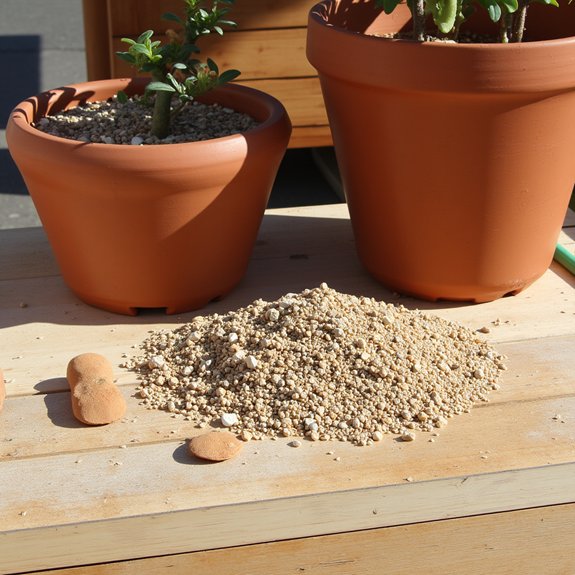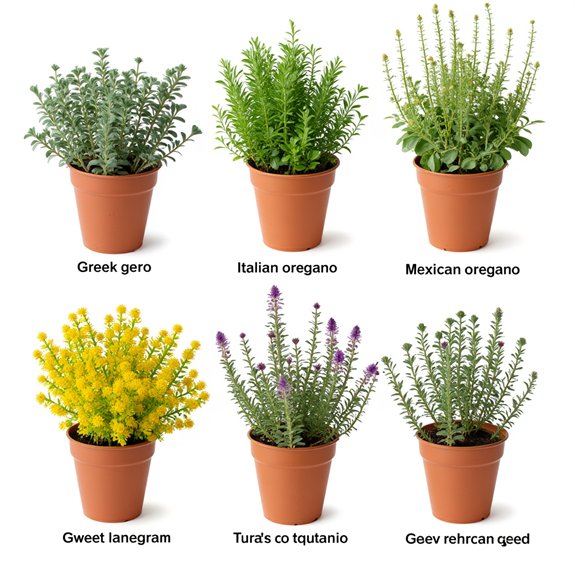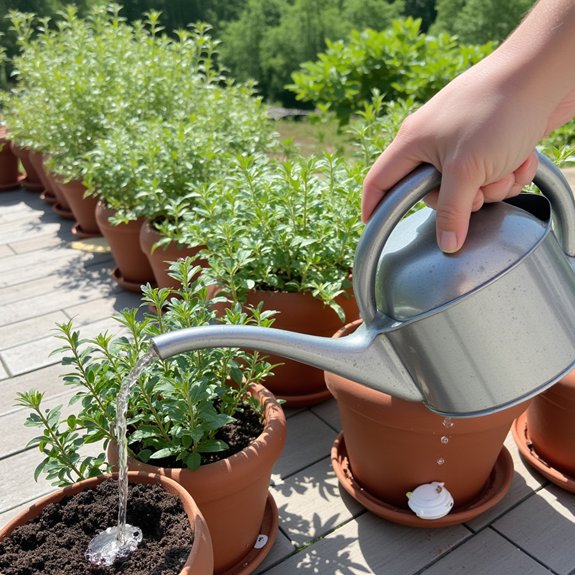Like the ancient Greeks who prized oregano as a symbol of joy and happiness, you’ll discover that growing this aromatic herb in containers transforms your gardening experience into something truly rewarding. You don’t need sprawling garden beds or perfect soil conditions to cultivate robust, flavorful oregano plants. Container gardening offers complete control over your herb’s environment, from drainage to positioning. However, success depends on mastering specific techniques that most gardeners overlook, and these secrets will determine whether your oregano thrives or merely survives.
Contents
- 1 Selecting the Perfect Container and Soil Mix for Oregano Success
- 2 Optimizing Light Exposure and Positioning for Maximum Growth
- 3 Comparing Oregano Varieties to Find Your Ideal Match
- 4 Starting From Seeds vs. Transplants: Making the Right Choice
- 5 Mastering Proper Watering Techniques for Healthy Plants
- 6 Essential Pruning and Maintenance Practices for Thriving Oregano
- 7 Preventing and Managing Common Pests and Diseases
- 8 Timing and Techniques for Peak Oregano Harvesting
- 9 Maximizing the Advantages of Container Growing Methods
- 10 Troubleshooting Common Challenges in Oregano Cultivation
Selecting the Perfect Container and Soil Mix for Oregano Success

When you’re starting your oregano container garden, the foundation of success lies in selecting the right pot and soil combination. Your container selection should prioritize a minimum 12-inch diameter with excellent drainage holes to prevent waterlogging.
Soil drainage becomes essential for oregano’s health. Choose a lightweight, well-draining potting mix enhanced with perlite or horticultural sand. Sandy loam works perfectly, maintaining that vital balance between moisture retention and drainage.
Your oregano isn’t fussy about pH levels, thriving in neutral ranges around 6.5-7. Skip the nutrient-rich soils – oregano actually performs better in lean, well-draining conditions that promote robust root development.
Optimizing Light Exposure and Positioning for Maximum Growth
Your oregano’s container setup means nothing without proper sunlight positioning. Place containers where they’ll receive at least six hours of direct sunlight daily. Light positioning becomes essential during hot summers, when afternoon shade protects plants from scorching temperatures above 80°F.
Monitor your oregano’s growth patterns throughout the season. If stems become leggy or flavor weakens, insufficient light’s the culprit. Practice sunlight rotation by moving containers weekly, ensuring even exposure on all sides. This prevents lopsided growth, promotes bushier plants.
Position containers one to two feet apart, allowing proper airflow between plants while maximizing individual light exposure for ideal oregano development.
Comparing Oregano Varieties to Find Your Ideal Match

Which oregano variety matches your culinary goals and garden aesthetics? Greek oregano delivers the most intense oregano flavor profiles, packing high oil content that’s perfect for Mediterranean dishes. Common oregano offers milder, sweeter notes ideal for everyday cooking. Hot and Spicy oregano brings pungent heat to your oregano culinary uses, while ornamental varieties like ‘Kent Beauty’ prioritize visual appeal over flavor. True oreganos outperform Mexican and Cuban varieties for authentic taste. Consider your cooking style: Greek for bold flavors, Common for versatility, Hot and Spicy for heat lovers. Match variety to intended use for best results.
Starting From Seeds vs. Transplants: Making the Right Choice
How do you decide between sowing oregano seeds or buying established transplants for your container garden? Smart seed selection offers variety and cost savings, while transplants provide instant gratification. Seeds germinate in 1-2 weeks at 70℉, requiring patience but delivering satisfaction. Start them indoors six weeks before your last frost date for best results. Transplant timing matters—nursery plants give you a head start on harvesting. Direct sowing works after frost danger passes, though you’ll wait longer for harvestable leaves. Consider your timeline, budget, and patience level when making this choice.
Mastering Proper Watering Techniques for Healthy Plants

Once your oregano plants are settled in their containers, getting the watering right makes or breaks your growing success. You’ll want to provide about one inch of water weekly, focusing on deep, infrequent soaking rather than daily sprinkling. This ideal watering approach encourages strong root development and prevents shallow root systems.
Check moisture levels by sticking your finger into the soil—water only when it’s dry. Drench the roots thoroughly, then let the soil dry out completely before the next watering. This technique prevents overwatering, which causes more oregano deaths than drought conditions.
Essential Pruning and Maintenance Practices for Thriving Oregano
While oregano practically grows itself, strategic pruning transforms scraggly plants into productive powerhouses that’ll keep your kitchen stocked all season long. Your pruning techniques should start with aggressive spring shearing, cutting plants down to ground level when new growth appears. This harsh treatment encourages bushy, compact development rather than leggy stems.
Maintenance schedules become simple once you establish the rhythm. Divide oregano every 2-3 years to refresh growth and create new plants. Throughout the growing season, pinch flower buds to maintain leaf production, though letting some bloom attracts beneficial pollinators to your container garden.
Preventing and Managing Common Pests and Diseases
Although oregano’s pungent aroma naturally repels most garden pests, you’ll still need to watch for occasional troublemakers that can damage your container herbs. Effective pest identification starts with regular plant inspections, checking leaves and stems for aphids, spider mites, or whiteflies. If you spot pests, blast them off with a strong water spray rather than using chemicals.
Disease prevention focuses primarily on avoiding overwatering and ensuring proper air circulation around your containers. Root rot from soggy soil is oregano’s biggest enemy. Water only when soil feels dry, maintain drainage holes, and space containers adequately for airflow.
Timing and Techniques for Peak Oregano Harvesting
Proper timing transforms ordinary oregano into a powerhouse of flavor, and you’ll want to start harvesting once your plants reach at least 6 inches tall. These timing tips guarantee maximum potency in your herbs.
Morning harvesting techniques work best, right after dew evaporates but before afternoon heat intensifies. Simply snip stems with clean scissors, cutting just above leaf nodes to encourage bushy regrowth. You can harvest continuously throughout the growing season.
Fresh oregano offers milder flavor than dried versions. For drying, spread leaves on parchment paper and bake at low temperatures, then crush and store in airtight jars for year-round culinary adventures.
Maximizing the Advantages of Container Growing Methods
Container growing transforms oregano cultivation into a manageable, rewarding experience that gives you complete control over your herb’s environment. You’ll prevent oregano’s natural spreading habit while ensuring ideal drainage conditions. Container benefits include mobility for sunlight optimization, protection from harsh weather, and easier harvesting access.
Smart pot selection starts with minimum 12-inch diameter containers featuring adequate drainage holes. You can relocate plants seasonally, moving them indoors during extreme cold or repositioning for better light exposure. This controlled environment lets you monitor soil moisture precisely, preventing overwatering issues common in ground plantings while maximizing your oregano’s flavor potential.
Troubleshooting Common Challenges in Oregano Cultivation
Even experienced gardeners encounter setbacks when growing oregano, but most problems stem from just a few common mistakes. Overwatering causes yellowing leaves and root rot, while underwatering leads to wilting and stunted growth. Check soil moisture before watering—it should be dry an inch down.
Nutrient deficiencies rarely affect oregano since it thrives in lean soil. However, pale leaves might indicate poor drainage rather than fertilizer needs. Environmental stressors like insufficient sunlight create leggy, flavorless plants. Verify six hours of direct sun daily, and prune regularly to maintain bushy growth and prevent your oregano from becoming unruly.
